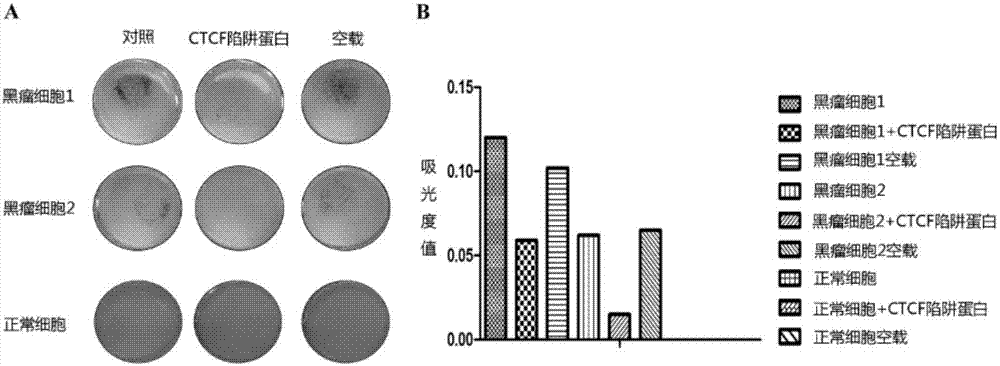Application of CTCF snare protein in preparation of anti-uveal melanoma medicine
A technology for melanoma and uvea, which is applied in the field of application of CTCF trap protein in the preparation of anti-uveal melanoma drugs, can solve the problems of unclear curative effect and mechanism of action of uveal melanoma, reduce the enucleation rate, improve Effectiveness of treatment, effect of improving visual prognosis
- Summary
- Abstract
- Description
- Claims
- Application Information
AI Technical Summary
Problems solved by technology
Method used
Image
Examples
Embodiment 1
[0020] Cell Proliferation Assay (CCK8)
[0021] Experimental materials: CCK8 was purchased from Japan Tongren Chemical Co., Ltd.
[0022] Construct CTCF trap protein stably expressing UM and normal cell lines, add lentivirus containing CTCF trap protein to UM cells and normal cells, 37°C, 5% CO 2 Cultured for 48 hours, after subculture, they were selected with puromycin at a final concentration of 8ug / ml for 4 weeks. After verifying the expression of CTCF trap protein by Realtime PCR, inoculate stable transgenic cells and tumor cells in 96-well plate, 5000 cells per well, 100ul medium, 37°C, 5% CO 2 For culture, add 10ul CCK8 at 0h, 24h, 48h, and 72h respectively, and continue to incubate at 37°C for 4h. The absorbance value measured on the machine is shown in figure 2 . from figure 2 It can be concluded that the trap CTCF protein can significantly inhibit the proliferation of uveal melanoma, and has no effect on the proliferation ability of normal cells.
Embodiment 2
[0024] Experiment name: Transwell cell migration experiment
[0025] Experimental materials: Transwell cells were purchased from millipore (Millipore, USA); six-hole plates were purchased from ThermoFisher (Thermo Fisher, USA); crystal violet was purchased from Sangon (Sangon China).
[0026] Experimental procedure: use 8μm 24-well plate Transwell chamber. Add 900 μl of 10% FBS DMEM culture solution to each well of the 24-well plate, hang the chambers in 24 wells, and inoculate 10,000 cells in 200 μl 2% FBS DMEM culture solution in each chamber. After culturing for 2 to 3 days, suck off the culture medium in the wells and small chambers, and carefully wash once with PBS. Add crystal violet for staining for 30 minutes, and carefully wash once with PBS. All the cells tested in the chamber were wiped clean. The outer cells of the small chamber were photographed for observation. Dissolve the crystal violet completely with 33% acetic acid solution, measure the OD value with a m...
Embodiment 3
[0028] Subcutaneous tumor formation experiment in nude mice
[0029] Experimental materials: 4-week-old male nude mice (provided by the SPF animal room of the Ninth People's Hospital Affiliated to Shanghai Jiao Tong University School of Medicine)
[0030] Experimental procedure: UM cells and stable cells were counted and centrifuged at 800rpm for 5 minutes, and each nude mouse was subcutaneously injected with 3*10 6 The cells were cultured for one week and the size of subcutaneous tumors in nude mice was measured. The size of the subcutaneous tumors in nude mice was measured twice a week. After 28 days, the nude mice were killed, and the tumors were taken out and weighed. See the experimental results Figure 4 ,from Figure 4 It can be concluded that the trap CTCF protein can significantly inhibit the tumorigenic ability of uveal melanoma in vivo.
PUM
 Login to View More
Login to View More Abstract
Description
Claims
Application Information
 Login to View More
Login to View More - R&D
- Intellectual Property
- Life Sciences
- Materials
- Tech Scout
- Unparalleled Data Quality
- Higher Quality Content
- 60% Fewer Hallucinations
Browse by: Latest US Patents, China's latest patents, Technical Efficacy Thesaurus, Application Domain, Technology Topic, Popular Technical Reports.
© 2025 PatSnap. All rights reserved.Legal|Privacy policy|Modern Slavery Act Transparency Statement|Sitemap|About US| Contact US: help@patsnap.com



